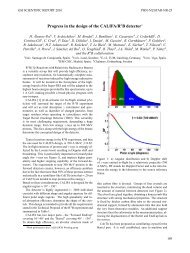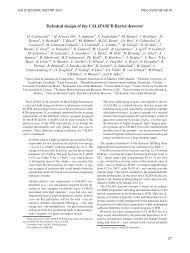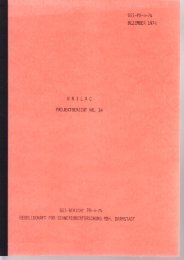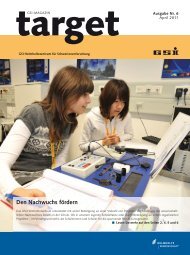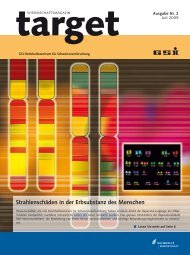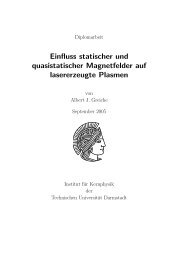download block - GSI Helmholtzzentrum für Schwerionenforschung
download block - GSI Helmholtzzentrum für Schwerionenforschung
download block - GSI Helmholtzzentrum für Schwerionenforschung
Create successful ePaper yourself
Turn your PDF publications into a flip-book with our unique Google optimized e-Paper software.
<strong>GSI</strong>-ACCELERATORS-06 <strong>GSI</strong> SCIENTIFIC REPORT 2009<br />
SIS18 Status Report<br />
P. Spiller, R. Balss, O. Boine-Frankenheim, U. Blell, Y. El-Hayek, H. Eickhoff, G. Franchetti, P. Hülsmann,<br />
M. Kirk, H. Klingbeil, H.G. König, H. Kollmus, U. Laier, C. Mühle, A. Parfenova, D. Ondreka,<br />
H. Ramakers, H. Reich-Sprenger, M. Schwickert, J. Stadlmann, H. Welker<br />
INTRODUCTION<br />
Beside the main upgrade program dedicated to the acceleration<br />
of low charge state heavy ions for FAIR [1], several measures<br />
have been initiated and completed which improve the<br />
beam performance for the running experimental program. The<br />
machine development program for high intensity operation and<br />
nonlinear dynamics studies has been intensified [2, 3, 4, 5].<br />
TRANSFER OF UNILAC BEAMS<br />
Low energetic (4 MeV/u) Xe-beams from the UNILAC<br />
could be transferred without acceleration through SIS18 to the<br />
ESR. By means of a slightly modified tune, setting of horizontal<br />
steerer magnets and switched-off bumper magnets, the<br />
UNILAC beam could be guided directly from the injection<br />
channel towards the extraction channel to the high energy beam<br />
transport system. SIS18 has only been used as a transport system<br />
and the UNILAC beams could be sent to the ESR [6] for<br />
potential use at the HITRAP experiment.<br />
BEAM LOSS AT MULTITURN INJECTION<br />
Depending on the emittance of the injected UNILAC beam<br />
and the actual settings of the injection devices, beam loss of the<br />
order of typically 30% is unavoidable during the transverse<br />
multi turn injection process. In order to minimize the multi turn<br />
injection losses, the scraper system in section 6 and 7 of the<br />
transfer channel may be used to cut of the tails of the injected<br />
beam. Precondition is an imaging optical system in between the<br />
scrapers and the injection septum, including three turns of revolution.<br />
Such an optical setting could be realized by means of<br />
emittance measurements with an updated MIRKO model of the<br />
beam transport and injection system. In the frame of machine<br />
experiments, it could be demonstrated that the beam intensity<br />
may be maintained in the SIS after cutting 25 % percent of the<br />
total intensity of the injected beam [7].<br />
BEAM OPTICS STUDIES<br />
The development of the Nonlinear Tune Response Matrix<br />
method (NTRM) for the reconstruction of nonlinear field errors<br />
was continued. The first attempts have been performed to reconstruct<br />
the natural sextupolar field components of the ring's<br />
main dipoles. The β-functions of the machine were systematically<br />
measured to determine the tune response of quadrupole<br />
and sextupole magnets [8]. According to the carried out measurements<br />
and simulations, the β-functions may be affected by<br />
the CO induced β-beating. The initial CO distortion in the presence<br />
of sextupoles leads to a β-beating via the feed-down of<br />
quadrupolar components. The uncontrolled β-beating, affects<br />
the nonlinear field error reconstruction and may also affect the<br />
efficiency of the multiturn injection and slow extraction. Therefore,<br />
it is important to correct the CO at the best in order to<br />
keep the β-functions symmetric. The new SISMODI closed<br />
orbit correction software was tested. However, the horizontal<br />
CO correction suffers from missing bipolar power converters.<br />
134<br />
<strong>GSI</strong> Darmstadt, Germany<br />
BUNCH COMPRESSION<br />
The first bunch compressor cavity based on magnetic alloy<br />
ring cores as inductive load has been installed in the SIS18<br />
synchrotron and commissioned with beam [9]. The new cavity<br />
provides a compression voltage of up to 40 kV in Rf pulses<br />
with a length of 500 ns. So far, one of the Fe-loaded acceleration<br />
cavities with a maximum voltage of 14 kV, has been used<br />
for compression for e.g. plasma physics experiments. Although<br />
the implementation of the new cavity in the accelerator control<br />
system was not completed, first compression experiments could<br />
be performed on the injection plateau and at final energy. The<br />
experiments at final energy were partly performed in combination<br />
with one of the Ferrit-loaded acceleration systems.<br />
BUNCH TRIMMING<br />
For a further reduction of the pulse length on the target and<br />
especially for a removal of the leading and following beam<br />
tails, the extraction kicker system may be used. This method is<br />
based on the fact that the acceptance angle of the extraction<br />
channel is a small fraction of the total kick angle. By igniting<br />
the kicker after the leading tail and shortening before the following<br />
tail, only the core of the bunch is extracted. However,<br />
the particles of the tails are dumped and distributed in the synchrotron.<br />
It could be shown, that by means of the extraction<br />
kicker trimming, the core of a compressed bunch may be cut<br />
out and pulse lengths of a few ten nanoseconds may be<br />
achieved on the target (Figure 1). See also [10].<br />
Figure 1: Intensity profiles of extracted single bunches<br />
measured with the fast transformer in TE1, without compression<br />
(long), with compression (medium) and with compression<br />
and extraction kicker trimming (short peaked).<br />
REFERENCES<br />
[1] P. Spiller et al, this annual report<br />
[2, 3, 4, 5] S. Appel, G. Franchetti, S. Sorge, this annual report<br />
[6] J. Stadlmann, internal note,<br />
www.gsi.de/beschleuniger/sis18/einstellung_steuerung.html<br />
[7] Y. El-Hayek, Masterthesis, <strong>GSI</strong> Master 2009-01 (2010)<br />
[8] A. Parfenova et. al., internal note,<br />
https://www.gsi.de/documents/DOC-2009-Nov-94-1.pdf.<br />
[9] P. Hülsmann et al, Proc. of the EPAC04, Lucerne (2005)<br />
[10] A. Tauschwitz et al, this annual report





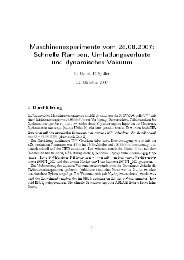
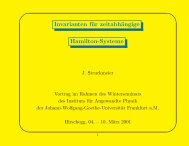
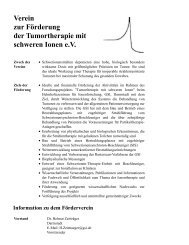
![GS I -P-]-17 - GSI Helmholtzzentrum für Schwerionenforschung](https://img.yumpu.com/20698964/1/184x260/gs-i-p-17-gsi-helmholtzzentrum-fur-schwerionenforschung.jpg?quality=85)

